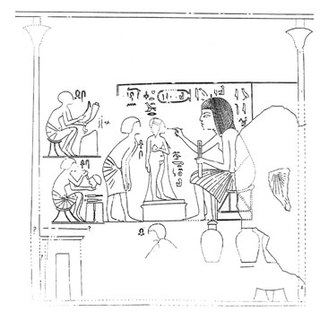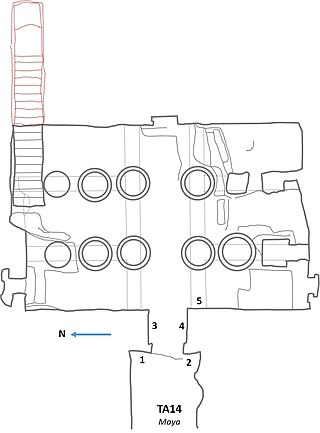
Nefertiti ) was a queen of the 18th Dynasty of Ancient Egypt, the great royal wife of Pharaoh Akhenaten. Nefertiti and her husband were known for their radical overhaul of state religious policy, in which they promoted the earliest known form of monotheism, Atenism, centered on the sun disc and its direct connection to the royal household. With her husband, she reigned at what was arguably the wealthiest period of ancient Egyptian history. Some scholars believe that Nefertiti ruled briefly as Neferneferuaten after her husband's death and before the ascension of Tutankhamun, although this identification is a matter of ongoing debate. If Nefertiti did rule as Pharaoh, her reign was marked by the fall of Amarna and relocation of the capital back to the traditional city of Thebes.

Meritaten, also spelled Merytaten, Meritaton or Meryetaten, was an ancient Egyptian royal woman of the Eighteenth Dynasty of Egypt. Her name means "She who is beloved of Aten"; Aten being the sun-deity whom her father, Pharaoh Akhenaten, worshipped. She held several titles, performing official roles for her father and becoming the Great Royal Wife to Pharaoh Smenkhkare, who may have been a brother or son of Akhenaten. Meritaten also may have served as pharaoh in her own right under the name Ankhkheperure Neferneferuaten.
Southern Tomb 23 is a sepulchre in Amarna, Egypt. It was used for the burial of Any, whose titles included, Royal scribe, Scribe of the offering-table of the Aten, Steward of the estate of Aakheperura.
Penthu was an Egyptian noble who bore the titles of sealbearer of the King of Lower Egypt, the sole companion, the attendant of the Lord of the Two Lands, the favorite of the good god, king's scribe, the king's subordinate, First servant of the Aten in the mansion of the Aten in Akhetaten, Chief of physicians, and chamberlain. These titles alone show how powerful he would have been in Eighteenth Dynasty Egypt.

Amarna art, or the Amarna style, is a style adopted in the Amarna Period during and just after the reign of Akhenaten in the late Eighteenth Dynasty, during the New Kingdom. Whereas Ancient Egyptian art was famously slow to change, the Amarna style was a significant and sudden break from its predecessors both in the style of depictions, especially of people, and the subject matter. The artistic shift appears to be related to the king's religious reforms centering on the monotheistic or monolatric worship of the Aten, the disc of the Sun, as giver of life.

Meketaten was the second daughter of six born to the Egyptian Pharaoh Akhenaten and his Great Royal Wife Nefertiti. She likely lived between Year 4 and Year 14 of Akhenaten's reign. Although little is known about her, she is frequently depicted with her sisters accompanying her royal parents in the first two-thirds of the Amarna Period.

Neferneferuaten Tasherit or Neferneferuaten the younger was an ancient Egyptian princess of the 18th Dynasty and the fourth daughter of Pharaoh Akhenaten and his Great Royal Wife Nefertiti.

Beketaten (14th century BCE) was an ancient Egyptian princess of the 18th Dynasty. Beketaten is considered to be the youngest daughter of Pharaoh Amenhotep III and his Great Royal Wife Tiye, thus the sister of Pharaoh Akhenaten. Her name means "Handmaid of Aten".

Amarna Tomb 1 is a sepulchre near Amarna, Upper Egypt. It is the tomb of the ancient Egyptian noble Huya, which is located in the cluster of tombs known collectively as the Northern tombs.
Mahu was Chief of Police at Akhetaten.

The tomb of Meryra is part of a group of tombs located near Amarna, Upper Egypt. Placed in the mountainsides, the graves are divided into north and south groupings; the northern tombs are located in the hillsides and the southern on the plains. Meryra's burial, identified as Amarna Tomb 4 is located in the northern cluster. The sepulchre is the largest and most elaborate of the noble tombs of Amarna. It, along with the majority of these tombs, was never completed. The rock cut tombs of Amarna were constructed specifically for the officials of King Akhenaten. Norman de Garis Davies originally published details of the Tomb in 1903 in the Rock Tombs of El Amarna, Part I – The Tomb of Meryra. The tomb dates back to the 18th Dynasty.
Mutbenret or Mutnodjmet was an Egyptian noblewoman, and said to be the sister of the King's Great Wife Nefertiti.

Amarna Tomb 3 is a rock-cut cliff tomb located in Amarna, Upper Egypt. The tomb belonged to the Ancient Egyptian noble Ahmes (Ahmose), who served during the reign of Akhenaten. The tomb is situated at the base of a steep cliff and mountain track at the north-eastern end of the Amarna plains. It is located in the northern side of the wadi that splits the cluster of graves known collectively as the Northern tombs. Amarna Tomb 3 is one of six elite tombs belonging to the officials of Akhenaten. It was one of the first Northern tombs, built in Year 9 of the reign of Akhenaten.

Amarna tomb 7 was one of the Southern tombs at Amarna, Egypt. It belonged to Parennefer, who was a pure handed cupbearer of the king's Person.
The Amarna Era includes the reigns of Akhenaten, Smenkhkare, Tutankhamun and Ay. The period is named after the capital city established by Akhenaten, son of Amenhotep III. Akhenaten started his reign as Amenhotep IV, but changed his name when he discarded all other religions and declared the Aten or sun disc as the only god. He closed all the temples of the other Gods and removed their names from the monuments. Smenkhkare, then Tutankhamun, succeeded Akhenaten. Discarding Akhenten's religious beliefs, Tutankhamun returned to the traditional gods. He died young and was succeeded by Ay. Many kings did their best to remove all traces of the period from the records. The Amarna art is very distinctive: the royal family was portrayed with extended heads, long necks and narrow chests. They had skinny limbs, but heavy hips and thighs, with a marked stomach.

The Tomb of Panehsy is a sepulchre in Amarna, Upper Egypt. It was erected for the noble Panehsy who bore the titles the First servant of the Aten in the house of Aten in Akhet-Aten, Second prophet of the Lord of the Two Lands Neferkheprure-Waenre (Akhenaten), the sealbearer of the King of Lower Egypt, Overseer of the storehouse of the Aten in Akhetaten, Overseer of cattle of the Aten in Akhet-Aten.
The Anonymous Tombs in Amarna are ancient Tombs of Nobles at the Royal Wadi in Amarna, Upper Egypt. They consist of both sepulchres and burial pits in varying stages of construction.

May was an ancient Egyptian official during the reign of Pharaoh Akhenaten. He was Royal chancellor and fan-bearer at Akhet-Aten, the pharaoh's new capital. He was buried in Tomb EA14 in the southern group of the Amarna rock tombs. Norman de Garis Davies originally published details of the Tomb in 1908 in the Rock Tombs of El Amarna, Part V – Smaller Tombs and Boundary Stelae. The tomb dates to the late 18th Dynasty.

Ipy, also transliterated as Apy, was a court official from the time of Amenhotep III and Akhenaten during the Egyptian 18th Dynasty. Ipy was High Steward of Memphis, and a royal scribe.
















